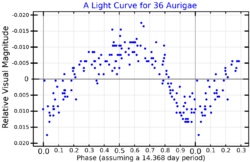Astronomy:36 Aurigae
| Observation data Equinox J2000.0]] (ICRS) | |
|---|---|
| Constellation | Auriga |
| Right ascension | 06h 00m 58.56230s[2] |
| Declination | +47° 54′ 06.9180″[2] |
| Apparent magnitude (V) | 5.71[3] |
| Characteristics | |
| Spectral type | A1 Vp Si[4] or B9.5p Si,Fe[1] |
| B−V color index | −0.007±0.004[3] |
| Variable type | α2 CVn[5] |
| Astrometry | |
| Radial velocity (Rv) | +15.8±2.1[3] km/s |
| Proper motion (μ) | RA: +4.186[2] mas/yr Dec.: −20.368[2] mas/yr |
| Parallax (π) | 3.5882 ± 0.1266[2] mas |
| Distance | 910 ± 30 ly (279 ± 10 pc) |
| Absolute magnitude (MV) | −1.97[3] |
| Details | |
| Mass | 4.42±0.43[6] M☉ |
| Luminosity | 724+348 −234[6] L☉ |
| Temperature | 10,046+522 −496[6] K |
| Rotational velocity (v sin i) | 20[7] km/s |
| Other designations | |
| Database references | |
| SIMBAD | data |
36 Aurigae is a single[9] variable star located about 910[2] light years away from the Sun in the constellation Auriga. It has the variable star designation V444 Aurigae, while 36 Aurigae is the Flamsteed designation.[8] This object is visible to the naked eye as a dim, white-hued star with a baseline apparent visual magnitude of 5.71. It is moving further from the Earth with a heliocentric radial velocity of +16 km/s.[3]
This is a magnetic chemically peculiar star that has been given stellar classifications of A1 Vp Si[4] and B9.5p Si,Fe,[1] indicating it is a late B- or early A-type star showing peculiarities of silicon and iron in the spectrum. It is an Alpha2 Canum Venaticorum variable that ranges in visual magnitude from 5.70 down to 5.74 with a period of 14.368 days.[5] The star has 4.4[6] times the mass of the Sun and is radiating 724 times the Sun's luminosity from its photosphere at an effective temperature of 10,046 K.[6]
References
- ↑ 1.0 1.1 1.2 Adelman, Saul J. (May 2005), "uvby FCAPT Photometry of the Magnetic Chemically Peculiar Stars 36 Aurigae, HR 2722, 13 Andromedae, and HD 220147", The Publications of the Astronomical Society of the Pacific 117 (831): 476–482, doi:10.1086/429640, Bibcode: 2005PASP..117..476A.
- ↑ 2.0 2.1 2.2 2.3 2.4 2.5 Brown, A. G. A. (August 2018). "Gaia Data Release 2: Summary of the contents and survey properties". Astronomy & Astrophysics 616: A1. doi:10.1051/0004-6361/201833051. Bibcode: 2018A&A...616A...1G. Gaia DR2 record for this source at VizieR.
- ↑ 3.0 3.1 3.2 3.3 3.4 Anderson, E.; Francis, Ch. (2012), "XHIP: An extended hipparcos compilation", Astronomy Letters 38 (5): 331, doi:10.1134/S1063773712050015, Bibcode: 2012AstL...38..331A.
- ↑ 4.0 4.1 Abt, Helmut A.; Morrell, Nidia I. (1995), "The Relation between Rotational Velocities and Spectral Peculiarities among A-Type Stars", Astrophysical Journal Supplement 99: 135, doi:10.1086/192182, Bibcode: 1995ApJS...99..135A.
- ↑ 5.0 5.1 Samus, N. N. et al. (2017), "General Catalogue of Variable Stars", Astronomy Reports, 5.1 61 (1): 80–88, doi:10.1134/s1063772917010085, Bibcode: 2017ARep...61...80S.
- ↑ 6.0 6.1 6.2 6.3 6.4 Netopil, Martin; Paunzen, Ernst; Huemmerich, Stefan; Bernhard, Klaus (July 2017), "An Investigation of the Rotational Properties of Magnetic Chemically Peculiar Stars", Monthly Notices of the Royal Astronomical Society 468 (3): 2745–2756, doi:10.1093/mnras/stx674, Bibcode: 2017MNRAS.468.2745N.
- ↑ Abt, Helmut A. et al. (July 2002), "Rotational Velocities of B Stars", The Astrophysical Journal 573 (1): 359–365, doi:10.1086/340590, Bibcode: 2002ApJ...573..359A.
- ↑ 8.0 8.1 "36 Aur". SIMBAD. Centre de données astronomiques de Strasbourg. http://simbad.u-strasbg.fr/simbad/sim-basic?Ident=36+Aur.
- ↑ Eggleton, P. P.; Tokovinin, A. A. (September 2008), "A catalogue of multiplicity among bright stellar systems", Monthly Notices of the Royal Astronomical Society 389 (2): 869–879, doi:10.1111/j.1365-2966.2008.13596.x, Bibcode: 2008MNRAS.389..869E.
External links
 |


